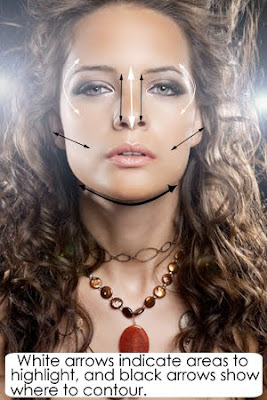 Q: What contouring products do you recommend?
Q: What contouring products do you recommend?
A: Before I get into what products I’d recommend, let’s go through the basic principles of contouring (and its complement–highlighting) to make sure we’re all on the same page! Techniques of contouring and highlighting play on principles of dark and light:
 Photo by Nadia Cheema
Photo by Nadia CheemaCONTOURING
When you want to make areas on the face appear smaller, we ‘contour’ by applying a darker shaded product atop the area.
i.e. to make the nose appear smaller, to add more definition to the cheeks, to slim down the face and make your decolletage pop!HIGHLIGHTING
When we highlight, we apply a lighter shaded product on the area we want to bring forward. Highlighting works well with contouring, as it helps to exaggerate your contour by contrasting against it.
See this post for more info on contouring + highlighting!
Some products that I would recommended:
MAC’s Sculpt & Shape powders (which I think is only available via macpro.com)
This collection of powders are a great option for those looking to subtly contour. These powders are smooth with just the right amount of pigment that your application won’t look streaky.
Make-up Forever’s Sculpting Kit
Each MUFE Sculpting Kit comes complete with two shades – one shade for higlighting and a darker shade for contouring. The powders are finely-milled and not too pigmented, so no need to worry about a streaky looking finish! The kits are also available in four different colour combinations making it easier to find a pair that works with your own skin.
Being resourceful…
You don’t necessarily need to use a product that’s specifically marketed for ‘contouring’ or ‘highlighting’. I’ve used concealers, foundations and eyeshadows as contour/highlight products in the past. Here’s how to do it:
1. The real key is always blending (so that’s where your finger, brushes and sponges come in handy!). Blend well to get rid of any harsh lines!
2. For contour, be sure to use matte products (i.e. no shimmer!), as any products with reflective particles will look obvious and reveal your contouring secret!
3. Don’t choose a shade that’s too dark for your contour (i.e. 2-3 shades darker should be sufficient!), as it can make the area you’ve applied it to look ‘dirty’ rather than a natural shadow.
4. When using eyeshadow as contour (on areas other than the eyes), lightly dip your brush in some loose translucent powder first before dipping into your eyeshadow. The initial coat of powder will ensure your pigmented eyeshadow doesn’t glide on too strong! Blend, blend, blend (yup, it’s my mantra!).
Hope this helps!
Rhia
If you have a make-up related question you’d like to ask, drop me an email: rhia[at]artistrhi[dot]com or send me a message through the W Network. I look forward to hearing from you!

